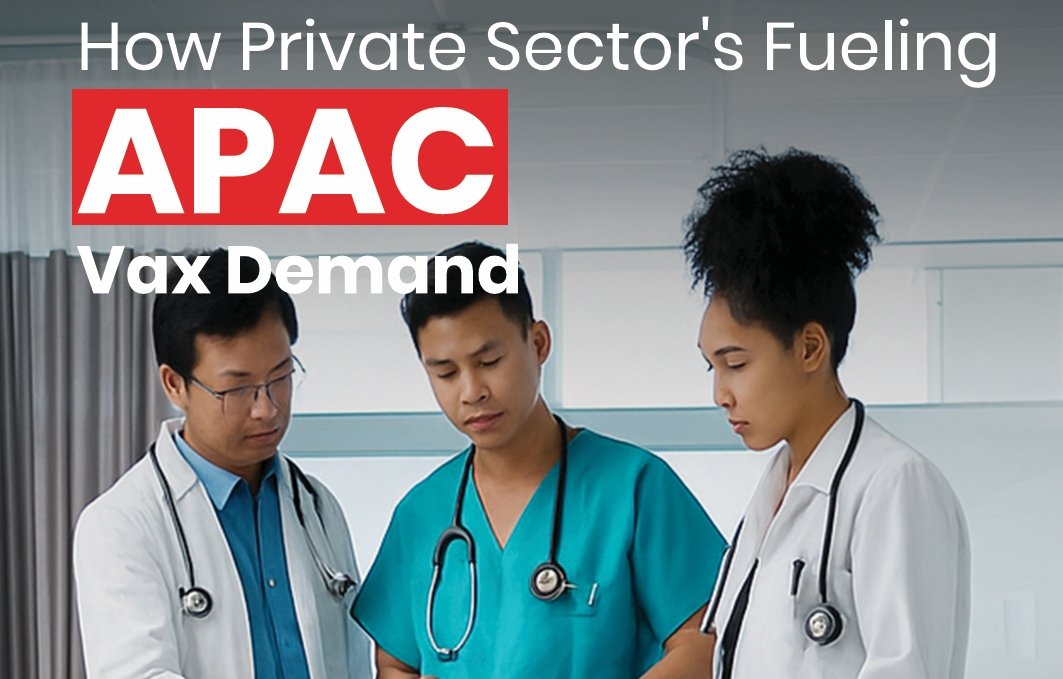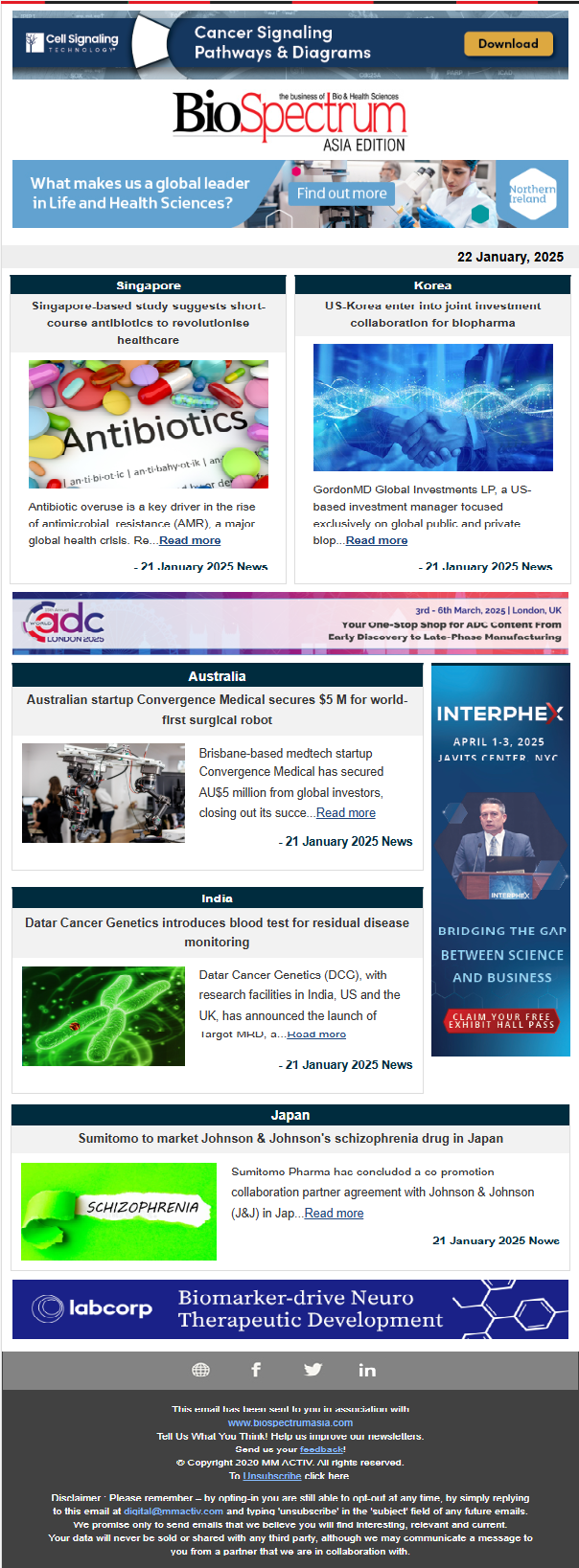
The vaccine landscape in Asia-Pacific is undergoing significant transformation and growth. While public-sector programmes have historically led immunisation efforts, the private sector is now emerging as a key growth driver reshaping access, innovation, and commercial strategy across the region. Private-sector vaccine sales account for an estimated 15–35 per cent of total uptake, with the strongest expansion seen in urban centres and middle-income economies where healthcare infrastructure is rapidly improving.
Private-sector vaccine sales in Asia-Pacific currently represent an estimated 20-30 per cent of total vaccine developers' revenue in the region as of 2024-2025. This marks a substantial evolution from approximately 10-15 per cent a decade ago, reflecting a fundamental shift in market dynamics.
The proportion varies significantly by country and market maturity.
“Currently, around 15–20 per cent of our vaccine business is driven by the private sector. While India’s vaccination landscape continues to be predominantly public-sector led through the Government’s Project Indradhanush initiative, the private segment is steadily growing—particularly in urban and semi-urban regions where parents are increasingly seeking flexibility, convenience, and access to newer combination vaccines,” said Dr Rajesh Jain, Chairman & Managing Director, Panacea Biotec Limited, India.
In most markets, public-sector procurement through national immunisation programmes remains the dominant channel for routine childhood vaccines. However, the private sector plays a much larger role in adult, travel, and non-routine (‘optional’) vaccines, especially in urban, high-income geographies and medical tourism hubs such as Singapore, Hong Kong, Malaysia, Thailand, Australia, New Zealand, and South Korea.
“Across markets like India, China, and Southeast Asia, the expansion of public programmes—such as the rollout of HPV vaccination—is shifting some private demand into public channels,” said Kavita Rekhraj, Life Sciences & Health Care Leader, Deloitte Asia Pacific & Southeast Asia.
She further said, “However, overall market value continues to rise as coverage expands. At the same time, pharmacy-based vaccination and medical tourism are giving a further boost to private-sector uptake across several Asia-Pacific markets.”
This shift is driven by several factors: a rising middle class with greater healthcare spending power, heightened post-pandemic health awareness, employer-sponsored immunisation initiatives, and proactive manufacturer strategies to build private-pay segments alongside public procurement. Government funding delays often leave gaps before new vaccines are added to national immunisation programmes, giving private channels an opportunity to provide early access. At the same time, rising consumer willingness to pay and stronger healthcare provider recommendations are shaping perceptions of vaccine value and choice.
“This shift has led vaccine developers to adjust their go-to-market strategies. New vaccines are launched through private channels first — building real-world evidence and awareness among early adopters. Simultaneously, engaging with government stakeholders and pursuing market access pathways to achieve inclusion in national immunisation programmes (NIPs),” said an IQVIA spokesperson.
Country-wise makeup
Across the Asia-Pacific region, private-sector vaccine sales account for roughly 15–35 per cent of market value, though the share varies widely by country and vaccine type. According to Deloitte, China leads with a 30–40 per cent private share driven by non–National Immunisation Programme (Category II) vaccines, while Southeast Asian markets such as Indonesia, Vietnam, and the Philippines show 20–35 per cent shares concentrated in urban centres. In India, private uptake for optional and adult vaccines like HPV and influenza represents around 20–30 per cent of the market.
Meanwhile, developed markets including Japan, South Korea, Australia, and New Zealand have smaller private shares—typically 10–20 per cent—as public programmes cover most routine immunisations. However, private demand for adult, travel, and lifestyle vaccines remains strong in hubs such as Singapore, Malaysia, and Hong Kong, where pharmacy-based vaccination and medical tourism continue to expand. Overall, urbanisation, rising middle-class incomes, and the growing popularity of travel and adult vaccines are driving the steady evolution of Asia’s private immunisation landscape.
Specific vaccine categories and therapeutic areas show disproportionate private-market penetration, driven by distinct demand patterns, particularly in the following segments:
Adult and Travel Vaccines: “These represent the fastest-growing private-sector segment. Influenza vaccines maintain consistent annual demand through corporate wellness programmes across urban Asia-Pacific. Pneumococcal conjugate vaccines (PCVs) for adults and elderly populations capture strong private-market share, particularly in aging societies like Japan, South Korea, and Singapore. Travel vaccines—including typhoid, rabies, yellow fever, Japanese encephalitis, and hepatitis A/B—are predominantly private-pay and have experienced substantial growth with post-pandemic tourism recovery,” said Rathanesh Ramasundram, Regional Practice Area Leader, APAC (Head of Healthcare & Life Sciences, Advisory), Frost & Sullivan.
Private clinics and pharmacies are key channels in Australia, Singapore, Malaysia, Hong Kong, Korea, and urban Indonesia and Philippines.
Sexually transmitted infections : “HPV vaccines demonstrate particularly strong private-market dynamics. While several countries have introduced school-based programmes (Malaysia achieved 80-90 per cent coverage through its national programme), substantial private demand persists from adults seeking catch-up vaccination and from consumers preferring nonavalent formulations over bivalent versions in public programmes. China and India are projected to account for one-third of the global HPV vaccine market by 2030, with domestic manufacturers introducing lower-cost alternatives that expand private accessibility,” said Rathanesh.
Premium and Combination Vaccines: Private consumers increasingly opt for combination vaccines (e.g., hexavalent formulations) that reduce the number of clinic visits, even when individual components are available through public programmes. Varicella and pneumococcal vaccines show 45-60 per cent private-sector uptake in some markets where they remain outside routine NIP schedules.
“EasySix, the world’s first fully liquid wP-IPV based hexavalent vaccine, contributes most to our private-market revenue due to the convenience of a 6-in-1 vaccine that lowers the number of injections, lower number of visits while meeting the same level of immune markers as the standalone vaccine. In the Indian private market, Panacea Biotec covers over 15,000 paediatricians across India to ensure availability of the vaccine for the self-pay private market. We are also working with global stakeholders for wider adoption in the public market. WHO SAGE has adopted the wP-IPV hexavalent vaccine for the global paediatric immunisation programme and is also supported by Gavi,” said Dr Rajesh Jain. He added, “We are also working with National Technical Advisory Group on Immunisation (NTAGI) to ensure adoption of the wP-IPV based Hexavalent vaccine in the Indian public market. Such adoption will reduce the burden of immunisation on parents, lower the loss of wage days for the parents, and help increase immunisation coverage rates in India while also lowering the economic burden.”
Vector-borne diseases: In tropical regions, vaccines for dengue and Japanese encephalitis are gaining momentum through private clinics. “PCV, Rotavirus, Meningococcal, Varicella, and Dengue vaccines are often outside public programmes and are primarily purchased privately in China, India, and across Southeast Asia,” said Kavita.
Private-Sector Influence on Market Trends and Strategy
The private-sector vaccine market in Asia-Pacific is transitioning from a supplementary to a strategic growth driver, becoming the fastest-growing channel within the region’s immunisation landscape. This shift is reshaping corporate priorities and long-term investment strategies for developers as vaccine uptake expands beyond government-led programmes.
“In the last few years, we have seen that parents visit private clinics to lower the number of needles, reduce the time taken for immunisation, and also seek convenience by going to the doctor near their homes. As Indian parents continue to prefer these factors, we see a trend towards private market immunisation beyond Tier I cities. Further, with growth of corporate hospitals and private clinics closer to the customer, we see a higher uptake in the paediatric market — a slow but positive trend,” said Dr Rajesh Jain.
In the next few years, Panacea Biotec is continuing to add new products across paediatric and adult segments. Its leading pipeline vaccines, NuCoVac-11 (a pneumococcal conjugate vaccine) and DengiAll (a tetravalent dengue vaccine), are already under Phase III clinical trials. These vaccines are suitable for both paediatric and adult populations. There has been a significant increase in pneumonia and dengue cases across all age groups in India. NuCoVac-11 is under clinical trials in the paediatric population, while DengiAll is in Phase III trials in adults aged 18–60, targeting all four dengue serotypes. As the burden of pneumonia and dengue continues to rise, Panacea Biotec expects these vaccines to play a critical role in expanding its private and institutional footprint across paediatric and adult populations over the next three to five years.
Moving forward, these dynamics are expected to shape R&D priorities across the region. The success of novel vaccine platforms in private markets is driving further research and development into adult, travel, and non-routine immunisations. “Vaccine manufacturers are allocating more funds toward adult, combination, and therapeutic vaccines (e.g., mRNA-based cancer and allergy vaccines),” said Rathanesh, reflecting a growing emphasis on differentiated, innovation-led portfolios that address emerging health needs beyond traditional immunisation programmes.
Regional partnerships are also becoming a cornerstone of vaccine developers’ strategies in Asia-Pacific, helping to strengthen market access and expand distribution capacity. “Expansion of collaborations with private hospital and clinic networks to strengthen access points,” said Rathanesh. These alliances are not only improving reach in urban markets but also supporting localisation and supply resilience across the region. She added, “To capture regional procurement and meet flexible private demand, particularly in India, China, and ASEAN.”
To achieve this, developers are prioritising on-the-ground production capabilities and long-term collaborations with domestic players. “To access both public and private channels, developers are investing in local manufacturing (notably in India, China, and Indonesia) and forming partnerships with local firms,” added Kavita.
At the same time, differentiated pricing strategies are becoming increasingly important as more vaccines move into public immunisation programmes. Developers are balancing affordability with profitability to remain competitive. “Vaccine manufacturers are adopting tiered models to balance public procurement volumes with higher returns from private payers,” said Rathanesh.
Digital engagement is also emerging as a key strategic pillar of growth. Developers and healthcare providers are leveraging direct-to-consumer education, telehealth integration, and smartphone-based immunisation tracking to drive awareness and uptake. “Pharmacy-based vaccination and digital health platforms are growing rapidly, especially for adult and travel vaccines. This requires new approaches to packaging, cold chain, and marketing,” said Kavita.
Policy shaping has become another critical area of private-sector influence. Data generated from private-sector uptake is increasingly informing public health decision-making and accelerating broader adoption and access. “Developers increasingly prioritise private launches to accelerate access and revenue, using these channels to generate data and build early market momentum. Evidence generated is then used to support public and government adoption, policy shaping, and drive broader healthcare initiatives,” said an IQVIA spokesperson.
Emerging trends suggest that medical tourism and rapid urbanisation will remain major drivers of private vaccine demand, particularly in Southeast Asia’s growing cities and tourism hubs. Regulatory harmonisation including alignment with ASEAN and ICH standards is simplifying approval pathways and enabling developers to introduce new vaccines more efficiently across multiple Asia-Pacific markets.
“Over the next 3 to 5 years, the private-sector for vaccines is poised to play an increasingly strategic role — not only as a source of revenue, but as a driver of innovation, expanded patient access, and policy evolution. For vaccine developers, success will depend on their ability to navigate dual-channel strategies, tailor offerings to wider demographics, and collaborate with both public and private stakeholders. In this rapidly evolving landscape, those who prioritise patient value and equitable access will be best positioned to drive meaningful impact across the region,” said an IQVIA spokesperson.
Echoing this view, Kavita noted that the private sector will remain central to vaccine growth and innovation. She said, “ The private sector will remain a major source of growth and innovation for vaccine developers in Asia-Pacific, especially in adult, travel, and lifestyle segments. As public programmes expand, the private-sector share may decline for some vaccines, but overall market value and innovation will remain robust, making private-sector strategy a top priority for vaccine companies in the region.”
As vaccine demand in Asia-Pacific becomes more diversified, the intersection of policy reform, regional partnerships, and private-sector participation will continue to define how the industry grows in the years ahead.
Ayesha Siddiqui




